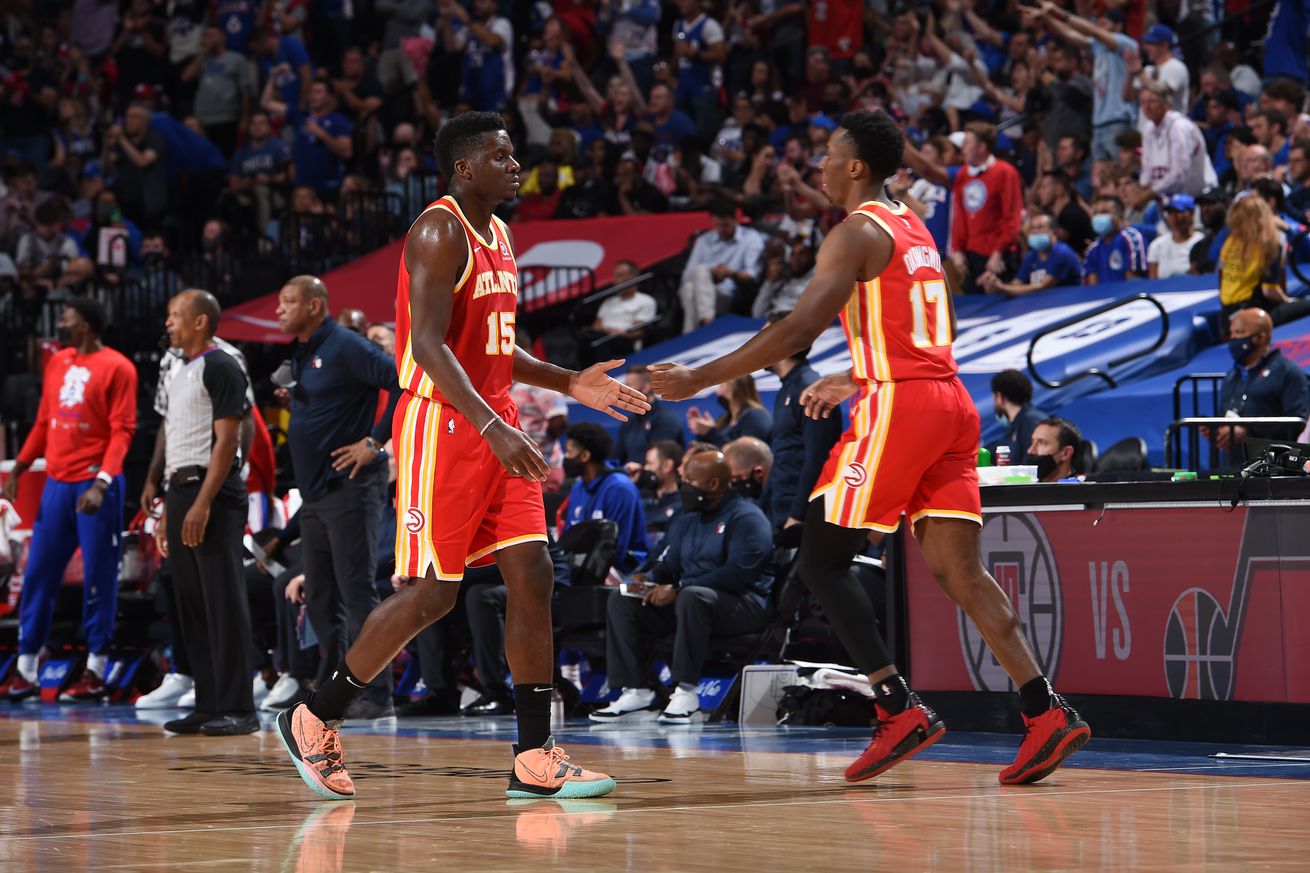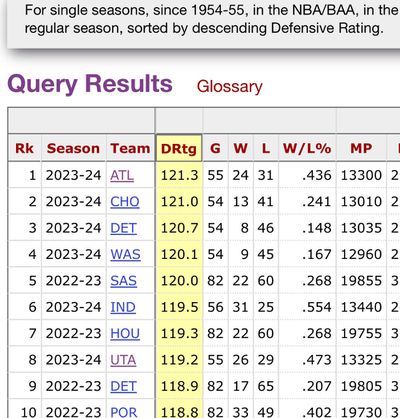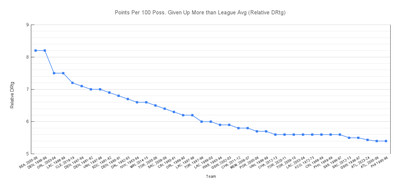
Earlier this week, we had a great profile from Hassan of the Hawks’ offense on the rise. But with the Hawks sitting at a disappointing 24-31 and tenth in the Eastern Conference, it’s obvious that the opposite side of the floor that is the main culprit for the performance to date.
The Hawks are on pace to secure a fourth straight top-10 offense, currently sitting at seventh at 118.8 points per 100 possessions per Basketball-Reference. However, they’ve ceded 121.3 points per 100 possessions on the defensive end as of the All-Star Break, which is the worst defense in the league – and by extension the worst defense in league history in terms of unadjusted defensive rating.
Don’t believe me?
We have per 100 possessions records dating back to 1950-51, prior to even the introduction of the shot clock. The 2023-24 Hawks are on a path to shattering the worst defensive net rating ever, albeit surrounded by a host of other recent teams.

I must point out that rule changes, refereeing changes, and a universal adaptation of pace-and-space principles have led to an offensive environment in 2023-24 unlike any other season in NBA history. Once you compare those figures to league average, the Hawks merely come in at 37th worst ever at 5.44 points per 100 possessions worse than league average as of February 22.

Still, you don’t get to be one of the 40 or so leakiest defenses in history by accident.
While the Hawks can certainly rebound over the last 27 games of the regular season, it’s pretty clear that this is a deeply flawed unit and one that needs an overhaul over the summer in one way or another.
But what is the source of the defensive struggles?
As the old sports adage goes, it’s either the “X’s and O’s” and/or the “Jimmies and Joes”. In other words, how much can be ascribed to tactics and execution and how much is plainly the personnel?
The X’s and O’s
The scheme switch was quickly evident, as far back as even the preseason.
Head coach Quin Snyder and his newly built staff implemented defending at or above the level of the screen on screening actions — at least to a higher frequency than before. This can also depend on pre-scouted opponents — i.e. who is involved in the action and their tendencies and abilities in specific situations. The aim was to trap dangerous ball handlers and blow up the play, (hopefully) forcing turnovers in the process.
From the start of the season to that point, the Hawks’ turnovers forced per 100 possessions had ticked upwards from 13.8 TOV% in 2022-23 to 14.3 TOV% per NBA stats.
It was always going to be a bumpy transition, as it requires even more choreography from the non-centers on the court to rotate behind the play as the screener defender attempts to recover. It also requires ball pressure and lengthy help defenders who need to clog up passing lanes as Atlanta defends momentary 4-on-3 situations.
The loss of Jalen Johnson to injury, and later De’Andre Hunter, strained an already thin perimeter defense to be able to execute this plan at a high level. Without dependable, switchable players, opposing teams have been able to pick on the backline of the Hawks defense.
Of course, the change didn’t have the intended effect of boosting the defense — and in fact it allowed the Hawks to be repeatedly beaten by drives and cuts to the rim.
The pivot came around a couple of disastrous losses to the Pacers, 150-106 in Indiana and 126-108 at home early this calendar year. The defensive scheme from then largely reverted to the familiar drop coverage of years past, one where the center plays below the level of screens.
There was a week in mid-January when the Hawks held there straight opponents to under 110 points — something that really shouldn’t be hailed as as big of an achievement as it was. But beyond that point in time, the defense continued to be sieve-like.
The Hawks both give up a large number of shots at the rim and do a poor job of deterring those same shots at the rim. As of the All-Star Break, Atlanta gives up the sixth-most shots per 100 possessions within the restricted area (six feet and in) and is tied for second-worst defensive FG% within the restricted area at 63.4%.
As an added bonus, Atlanta pairs halfcourt ineptitude with transition ineptitude, coming in at tied for the league-worst mark in points per 100 transition possessions. Even the defensive rebounding suffers when the bigs are pulled out of the paint.
Luka Doncic rather infamously put up 73 points in a January contest, often by drawing Clint Capela out on pick-and-roll coverage. Here, Doncic hits Tim Hardaway Jr. on a crosscourt pass. Hardaway opts to pull from deep despite Dereck Lively II only having to contend with players six inches or shorter than him once Jalen Johnson rotates out. Still, Lively is able to easily grab the rebound with Capela nowhere to be found.
But it’s the lack of rim protection that is most glaring from this season’s team. The Hawks have made a habit of rolling out red carpets for drives into the lane. Exhibit A: the infamous lowlight from Capela’s 40-foot defense from the same Mavericks game.
The benefit of Onyeka Okongwu is to use him as an uber switchable center, but the scheme breaks down if there are no low men rotating behind him when beat off the dribble.
This has been a recurring theme throughout all season — if you ask the center to step out to defend perimeter actions, you better have a plan for what happens after that. And Atlanta’s plan looks muddy at best.
The idea is also that in today’s NBA, centers need to be able to switch out to the perimeter and defend more skilled players. But it’s a five-man unit working together at all times. If the players behind the center can’t cover for their big man being pulled out of the paint, say with a low man rotating from the baseline, you’re essentially drawing dead.
This team suffers from ugly spells of inconsistent motor and rampant disjointedness. But even once committing to working hard and staying connected defensively, a clear lack of height, bulk, and length dooms them on a nightly basis.
The Jimmies and Joes
The Hawks have a small team, and there’s really no debate about that. Per Basketball Reference, based on minutes-weighted figures, the average Atlanta Hawk is 6-foot-6 and weighs 210 pounds. Size still rules to a degree in the NBA, despite a recent small ball/skill ball movement.
We’ve seen the Minnesota Timberwolves transform into a defensive juggernaut with the addition of 7-foot-2 rim protecting behemoth Rudy Gobert. The second-ranked Cleveland Cavaliers defense features two near 7-footers in Evan Mobley and Jarrett Allen. The third-ranked Boston Celtics defense can deploy still serviceable Al Horford alongside 7-foot-2 Kristaps Porzingis when health permits.
The Hawks countered with the 6-foot-10 Clint Capela, 6-foot-8 Onyeka Okongwu, and 6-foot-9 Bruno Fernando. That’s not to say that undersized centers can’t protect the rim at a high level or lead elite defenses, but this Atlanta team was never set up to be able to put that trio in an enviable position. Whereas the Miami Heat surround the 6-foot-9 Bam Adebayo (who overcomes his lack of size with incredible awareness and athleticism) with perimeter stoppers, the Hawks seemingly did the opposite.
Teams can also target certain Atlanta players with their offensive actions to put them in binds defending the ball or even in help situations.
Below is a ‘Spain pick-and-roll’ action, where there’s a second screen for the original screener. This whole play is called to target the 6-foot-1, 162-pound Trae Young as help guy, and the results aren’t pretty.
Saddiq Bey has to peel off his battle with Giannis Antetokuonmpo to defend a Brook Lopez middle screen slip. That then brings in Young as the help man, and there’s just not a lot he can do to counter the lob over the top.
In this next clip, Coby White rejects the screen and eliminates Jalen Johnson’s ability to switch onto the ball. I’m unsure why Saddiq Bey tries drawing charge, and Bey being targeting as the low man is often quite fruitful.
Dejounte Murray often gives Young and Bey a run for their money in terms of a lack of resistance helping at the rim. His hesitance here means he’s already lost the battle.
Bruno Fernando has had to step in during injuries to either Capela, Okongwu, or both. But a drop defense scheme is just not his forte.
Ultimately, for a defense this moribund, it’s the combination of scheme and roster makeup that works in tandem to contribute to a league-worst mark. Among the top fourteen teams in offensive rating this season, the Hawks are the only one with a negative net rating as of February 22.
The Hawks could be flying high behind their stellar offense, but their defense is such a dead weight that it’s meant a failure to launch for the 2023-24 campaign. The Hawks have roughly one-third of their regular season to figure things out. Or else they’ll go down in history with a footnote no team wants to own.
